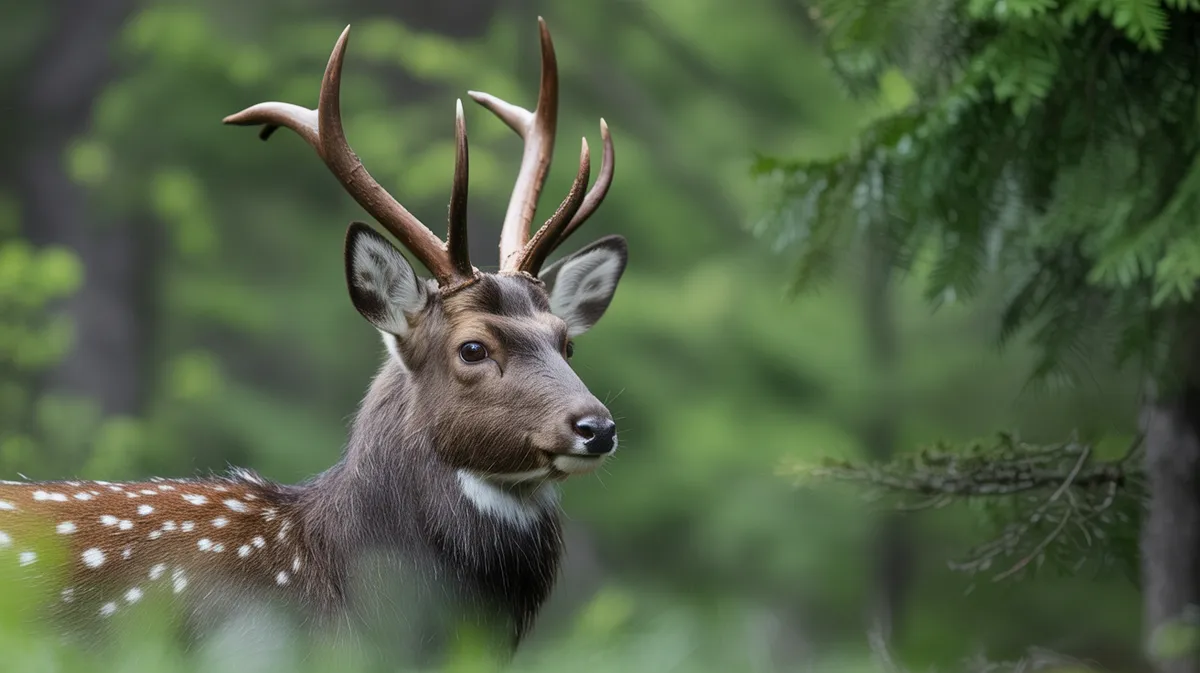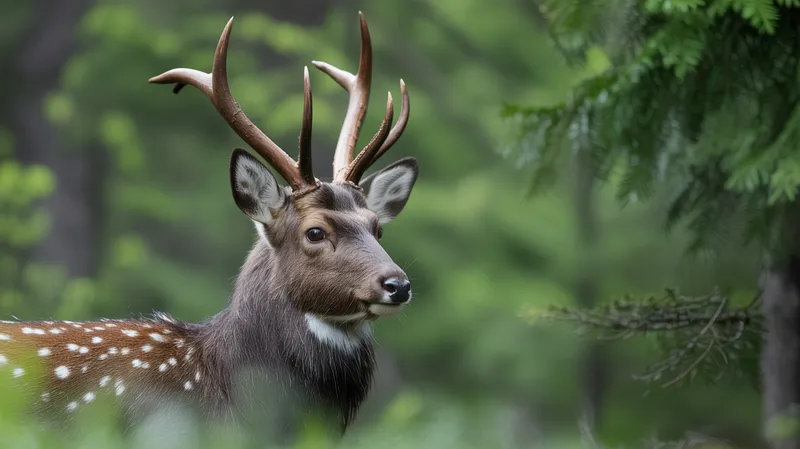
Siberian Musk Deer
Moschus moschiferus

Meet the Siberian Musk Deer
The Siberian Musk Deer is a small, elusive ungulate native to the forested mountainous regions of northeastern Asia. Unlike true deer, it lacks antlers and is distinguished by the long, curved canine teeth or 'tusks' present in males, which are used in territorial disputes and attracting mates. This nocturnal and solitary species is well adapted to cold environments, with dense fur and agile movements that help it navigate rugged terrain. Musk deer are named for the musk gland in males, which secretes a valuable substance historically used in perfumes and traditional medicines. Their secretive nature and preference for dense cover make them difficult to observe in the wild.
Classification
Mammal
Habitat
Mountainous forests and taiga
Diet
Herbivore
Lifespan
10-14 years
Conservation
Vulnerable
Weight
7-17 kg
📖Fascinating Facts
Tusked Deer
Unlike most deer, male Siberian Musk Deer have long, saber-like upper canine teeth that protrude like tusks and are used in fights for territory and mates.
Forest Specialist
This species is highly adapted to life in dense forests and taiga, using its agility to navigate steep, rugged terrain and thick undergrowth.
Valuable Musk
The musk gland of the male is highly valued in the perfume industry and traditional medicine, driving illegal hunting and contributing to their vulnerable status.
📋Detailed Description
The Siberian musk deer (Moschus moschiferus) is a small, primitive ungulate, typically measuring 70–100 cm in body length and weighing between 7 and 17 kg, with males slightly larger than females. Unlike true deer, it lacks antlers and instead features elongated upper canine teeth in males, forming prominent tusks up to 10 cm long, which are used in intraspecific competition and courtship displays. Its dense, coarse fur is grayish-brown, providing insulation against harsh winters in its taiga and montane forest habitats. The body is compact with relatively short limbs, aiding in maneuverability through dense undergrowth and steep, rocky terrain. The species is primarily nocturnal and crepuscular, relying on acute senses of smell and hearing to avoid predators. The Siberian musk deer is solitary outside of the breeding season, occupying well-defined home ranges marked with secretions from preputial and musk glands. Its diet consists mainly of lichens, mosses, leaves, twigs, and occasionally fungi, reflecting a highly selective browsing strategy. The animal is exceptionally elusive, often using well-worn trails and resting in dense cover during the day. Males possess a musk gland located between the navel and genitals, which produces a highly valued musk used in perfumery and traditional medicine, making the species a target for poaching.
💡 Did you know?
The musk gland secretion from male Siberian Musk Deer is so prized that it has led to extensive poaching, threatening the species' survival.
🔬Research & Sources
Wikipedia Summary
The Siberian musk deer is a musk deer found in the mountain forests of Northeast Asia. It is most common in the taiga of southern Siberia, but is also found in parts of Mongolia, Inner Mongolia, Manchuria and the Korean peninsula.
Last Modified: 4/4/2024
🎭Behavior & Social Structure
Siberian musk deer are solitary and territorial, with individuals maintaining overlapping home ranges of 2–30 hectares, depending on habitat quality. They are most active during dusk and dawn (crepuscular) and at night, foraging for food and patrolling their territories. During the day, they rest in dense vegetation or rocky crevices to avoid predation by wolves, lynx, and large raptors. Feeding behavior is highly selective; they prefer lichens (especially Usnea spp.), which can constitute up to 60% of their winter diet, supplemented by leaves, shoots, and bark in warmer months. Musk deer use scent marking extensively, depositing secretions from their preputial and musk glands on rocks, tree trunks, and vegetation to communicate presence and reproductive status. Social interactions are limited outside the breeding season, with encounters between adults often resulting in aggressive displays, especially among males. They are agile and capable of rapid, bounding movements to escape threats, often utilizing steep slopes and rocky outcrops for cover.
👶Reproduction & Life Cycle
The breeding season (rut) occurs from November to January. Males compete for access to females using their tusks in ritualized fights, which rarely result in serious injury. After mating, females undergo a gestation period of approximately 185–195 days, giving birth to one, rarely two, fawns in late spring or early summer (May–June). Newborns are well-camouflaged with spotted coats and remain hidden in dense vegetation for the first few weeks of life. Maternal care is pronounced; the female visits the fawn only briefly to nurse, minimizing scent trails that could attract predators. Weaning occurs at 3–4 months, but juveniles may remain with the mother until the following spring. Sexual maturity is reached at 1.5–2 years of age.
🛡️Adaptations & Survival
Siberian musk deer exhibit several adaptations for survival in cold, mountainous environments. Their dense, hollow-fibered fur provides excellent insulation against subzero temperatures. The small, compact body reduces heat loss, while elongated hind limbs enhance agility and leaping ability on rugged terrain. The absence of antlers reduces energy expenditure and risk of entanglement in dense undergrowth. Enlarged tusks in males serve as weapons in competition and as visual signals during the rut. Their highly selective diet, focused on lichens and other low-nutrient forage, is facilitated by a specialized digestive system with a large, multi-chambered stomach for fermenting fibrous plant material. Acute olfactory and auditory senses aid in predator detection and intraspecific communication.
📚Research Sources
🎨Cultural Significance
Musk from male Siberian musk deer has been used for centuries in traditional Chinese, Korean, and Tibetan medicine as an ingredient in remedies for a variety of ailments, and in perfumery as a fixative. The animal appears in regional folklore as a symbol of elusiveness and purity. Overharvesting for musk has led to the development of synthetic alternatives, but illegal trade persists. In some cultures, the deer is also associated with spiritual beliefs and is occasionally depicted in art and literature.
🔬Recent Research & Discoveries
Recent research has focused on population genetics, revealing significant genetic structuring among regional populations, which has implications for conservation management. Studies using camera traps and molecular scatology have improved understanding of habitat use and population densities. Advances in non-lethal musk extraction and captive breeding programs are being explored to reduce pressure on wild populations. Ongoing research also examines the ecological role of musk deer in forest ecosystems, particularly their influence on lichen communities and as prey for large carnivores.
🎥Wildlife Videos

Siberian Musk Deer: This Deer Is A Vampire
Meet the deer with the fangs of a vampire. Get Animalogic Merch: https://bit.ly/3SXGrXL Support Animalogic on Patreon: ...
Animalogic

Siberian Musk Deer: The Elusive Elegance of the Wild Siberia
"Siberian Musk Deer: The Elusive Elegance of the Wild Siberia" The Siberian Musk Deer, also known as Moschus moschiferus, ...
Familiarity With Animals (FWA)

Musk-Deer 2 (Animal.Planet.Wild.Russia.3of6).mp4
mamirmian

Wildlife documentary on Kashmir wildlife musk deer
چوہدری صاحب ♥️

Vampire Deer: The Siberian Musk Deer
Welcome to WildNature! Join us for thrilling Adventures in diverse Habitats, encountering Animals, exploring Exotic places, and ...
WILDNATURE

We Love Nature -The Rare and Exotic Animals of Siberia - Wildlife | Nature Documentary
Copyright * ▯ All materials in these videos are used for entertainment purposes and are governed by fair use guidelines.
Nguyễn Nhật
🌍Habitat Information
The Siberian Musk Deer typically inhabits Mountainous forests and taiga environments. Siberian Musk Deers have adapted to their environments with specialized features and behaviors.
Primary Habitat:
Mountainous forests and taiga
More detailed habitat information will be available soon.
🛡️Conservation Status
The Siberian Musk Deer is currently classified as Vulnerable. Conservation efforts are crucial for preserving this species for future generations.
Common Threats:
- 🏠Habitat loss and fragmentation
- 🌡️Climate change impacts
- 🎯Hunting and poaching
- 🏭Human-wildlife conflict
⚠️Threats & Conservation Challenges
The primary threat to Siberian musk deer is illegal hunting for musk, which is highly valued in the perfume industry and traditional medicine, with a single musk pod fetching high prices on the black market. Habitat loss and fragmentation due to logging, agricultural expansion, and infrastructure development further exacerbate population declines. Natural predators include wolves, lynx, and large birds of prey, but human-induced mortality far exceeds natural predation. Population trends are decreasing across much of the range, with local extinctions reported in some areas. Conservation challenges include insufficient law enforcement, lack of effective habitat protection, and limited data on population dynamics due to the species' elusive nature.
🔬Scientific Classification
Scientific Name
Moschus moschiferus
Classification Hierarchy
🔍 About Taxonomic Classification
Taxonomic classification is a hierarchical system used by scientists to classify and organize living organisms based on shared characteristics and evolutionary relationships.
The system moves from broad categories (Kingdom) to increasingly specific ones, with each animal's scientific name typically consisting of its Genus and species.
📝Community Notes
Share your observations and insights about the Siberian Musk Deer with our community of wildlife enthusiasts.
Join Our Community
Sign in to share your observations and connect with fellow wildlife enthusiasts.
Sign In to ContributeNo community notes yet
Be the first to share your observations about the Siberian Musk Deer!
Explore Siberian Musk Deer
Select a tab above to learn more about this amazing animal.
📸Photo Gallery
No photos available for this animal yet.
🌟Discover More Wildlife
Continue your journey of discovery with more fascinating animals from our database
